
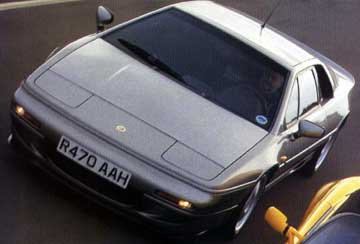
Live from Norwich
A year after Malaysian
money saved Lotus, the results show.
Three new cars, new bosses, a new light in the east.
CAR Magazine, January 1998
by John Simister, Richard Feast, Paul Horrel
Photography by Colin Curwood, Alex Puczyniec and Dominic Fraser
Much has happened at Lotus over the past 18 months. The V8 Esprit was launched before it was ready, but the spirit came back when the wonderful Elise wowed the world. Meanwhile, the company's future hung in the balance while its backers tried to wriggle their way out of bankruptcy, and for a time it looked as though the Elise, the best thing to happen to Lotus in decades, might wither on the vine.
Then came Hicom, parent to Proton, Malaysia's major motor-maker and the most unlikely of suitors, but well charged with the right stuff. Under Proton's majority ownership, investment has flowed in and Elises have flowed out of the Hethel factory at more than three times the rate – 2500 instead of 800 a year – originally envisaged. More Elises are being made in Malaysia, while Proton has got itself a ready-made research and development operation of high international standing.
A Lotus, the sense of relief is palpable. The signs are that Lotus is on a firmer financial footing than it has been for a very long time, even when under GM ownership. Now, it is honing its sports cars again, finishing the job it started with the Esprit V8 and sparkling up the already effervescent Elise.
CAR brings you the first drive in the latest Esprits with their long-overdue cabin and gearshift makeovers, and takes a look at the ultimate Elise conversion as created by the men who conceived the Elise in the first place. And after we drive the cars, we meet the people who'll be shaping the Lotus future.
It's a rebirth, and it's good. The story starts here, with the Lotus Esprit V8.
Lotus Esprit V8
Promise fulfilled, by vital changes that finally let you use its speed and handlingThis story begins with missed gearshifts, missed moments and a yellow Lotus Esprit V8. A year and a half ago, this was, Lotus, after years of will-it won't-it, finally put a V8 engine in the Esprit to silence its not-enough-cylinders critics. It was an all-new engine, a high-tech showcase for Lotus's thriving consultancy business, and it delivered muscle in abundance.
We should have been thrilled. But we were not. Despite awesome pace and a deft chassis, the yellow Lotus frustrated. Why? Because shifting from one gear to another, a simple matter you might think, was a major effort of arm flexure, foot manipulation, ankle stress and mental co-ordination. It put you in a bad mood.
And that mood was made worse by an interior little changed from the Esprit's first incarnation back in 1976. Dated, claustrophobic, ergonomically dire, it did the Esprit no favours at all. Here was Lotus's biggest chance in years to make the Esprit the car is should always have been, and they'd blown it. Unbelievable.
A year and a half on, the Esprit V8 gets an all-new interior, a proper 1990s setting for action. And it gets a clutch you can disengage with just one foot, and a gear linkage which transmits your movements to the gearbox with precision, without transmitting vibration back in return.
These changes, says Esprit platform manager Brian Angus (he's been an Esprit honer for 18 years), are in response to customer feedback. And, leaving aside the question of why Lotus didn't spot the transmission deficiencies itself before pointing the V8 at its dealers' showrooms (the company has backtracked to the extent of retro fitting, free of charge, the new clutch to customers' cars), the Esprit V8 in its fully sorted form shows every sign of being an alluring piece of kit.
Really? This Dorian Gray of supercars, alluring? Well, it's still a striking shape. Lights, spoilers, side skirts and wheel arch edges, steadily these fashion-vulnerable parts have all been modified since the current shape was new in 1987. Now, the interior finishes the job.
Your first impression is one of space, relatively speaking. The cabin sides are as high as ever, of course, but the centre tunnel is lower and that huge boomerang-shaped dashboard binnacle has gone. In its place is a simple curved cowl, covering a seriously diminished complement of dials. 'Customers wanted fewer instruments,' says Angus, so it's just speedo, tacho (bigger and easier to read now), flanked by gauges for fuel and coolant temperature. The turbo boost gauge, among others, has gone.
And where are the warning lights, formerly among the Esprit's crudest and naffest details? The dials sit on a background of textured grey – wood has been banished from the Esprit's cabin, which is right because a Lotus is not a woody car – whose surface is translucent layer through which a scattering of lights can shine. When extinguished, they are invisible. Neat.
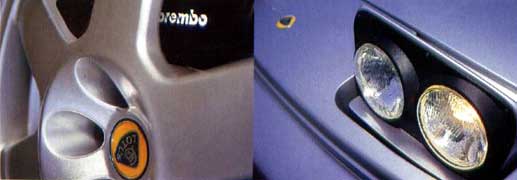
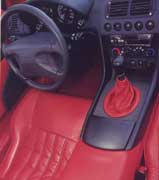
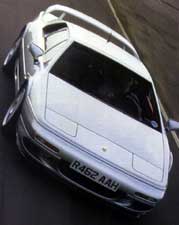
There's a hump in the facia's centre containing air vents and a row of round, dimpled switches familiar to anyone who drives a Peugeot 106 or, for that matter, a Lotus Elise. Further over there's a bigger glovebox. The four conventional vents replace the hand-freezing eyeballs previously scattered hither and thither, and the heater controls communicate electronically with their mechanisms instead of via cables. You can, al last, get the temperature you want where and when you want it. The windows now have one-touch operation, too.
The difference all this makes to the Esprit's all-togetherness is vast. Time, then, to find out if the new driving experience matches this magnitude of change. The main reason for the former ratio-shifting reluctance was that the clutch, in order to cope with 350bhp and 295lb ft from 3506cc of flat-crank V8, was vast: 280mm across. This meant lots of rotational inertia, and hard work for the synchromesh as it tried to match gear speeds with a heavy driven plate on the end of the input shaft. The heavy pressure plate on the flywheel spoiled the engine's blip-ability, too, which was particularly bad news in a turbo car (the Esprit has two blowers) with a soft off-boost throttle response.
The solution? A twin-plate AP Racing clutch, with smaller diameter and half the rotational inertia. Added to a new system of low-drag clutch hydraulics from German specialist FTE, the effort at the clutch pedal has halved and its travel is greatly shortened. Finally there's a new gear-selector linkage with many parts eliminated to cut down slop and noise transmission.
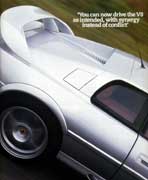

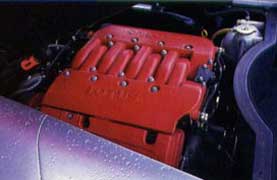
This involved redesigning the back of the Renault UN-1 gearbox, to take the new linkage. 'This gearbox is only used in the Lotus now,' says Brian Angus. 'The Alpine, the previous Espace, the Renault 25, the Master van, they're all dead. It's an old design, but Renault has upped and upped its torque capacity. The engineers would shake their heads and say there was nothing more they could do, but they always managed to squeeze a little more out of it. We're on the limit now, though.
'Renault has been very helpful. Nowadays the 'box is built in a corner of a truck factory, but still deal with the same gentlemen we dealt with back in the Europa days, when the Europa had a Renault engine. And it will continue for the foreseeable future.'
As soon as you press that clutch pedal, you feel the difference. The gearlever snicks into first with no rubberiness or lost motion, the clutch bits cleanly and we smooth off towards the horizon. The efforts feel easy, natural and, most important of all, they harmonise with those required to steer and, via a harder-biting ABS system from Kelsey-Hayes, brake.
In short, it feels as a Lotus should: precise, progressive, benign and massively quick. A bend approaches; brake, blip and downshift in one easy movement, point the nose precisely and feed in the power as the exit opens up. Turbocharged the Lotus might be – it obviates the need for fancy variable valve timing and resonating inlet manifolds – but the turbos are small and their boost pressure low. So, apart from the required size of the downchange blip, you're not really aware of the forced aspiration.
This is a mightily quick car, 175mph and 0-60 in 4.8 seconds, but even in the rain that soaked the latter part of our test it proved hugely grippy and almost laughably controllable. If the back end steps out under an excess of power, a flick of the quick steering and it's straight back in. Lovely. It would be even lovelier with a fruitier exhaust note, but cloth-eared Eurocrats have put paid to that.
You can now drive an Esprit V8 as intended, with synergy instead of conflict. And it finally, finally comes across as a proper, fully-developed car with a decent development budget behind it. If 1976 was the year of the original Esprit's birth, then 1997 is the new year Zero.
Lotus Esprit GT3
New cabin does no harm to the bargain, barking four-cylinder GT3This is a significant car in the Esprit's biography. When the first Esprit GT3 appeared a year ago, it brought the cost of Esprit ownership back down to a semi-sensible level (a relative snip at £39,950), and it got Lotus away from the notion that wood and leather were vital attributes of a supercar's cabin. The Elise got Lotus back on the track of a techno-feel ambience, and the GT3 built on this with its body-colour and aluminium cabin trimmings and its freedom from frills.
Its relatively stripped-for-action interior still suffered from the same old architecture, though. Now it, too, gets the new-look cabin, and it translates well in the switch from the V8's leather-clad luxury to the GT3's composite-and-vinyl ambience. There's no air-conditioning (it's an option), but the remaining heater controls gain the new electronic operation used in the V8.
The V8's revised, lighter Kelsey-Hayes ABS braking system, for which Lotus is the first European customer, also appears in the GT3, as does a new windscreen wiper which reaches further into the screen's extremities and stays stuck to the surface better.
Otherwise, it's GT3 as usual, the chief external differences between it and the V8 being the smaller five-spoke wheels and the absence of wheelarch eyebrows and are wing, an extended lower rear valance, and, obviously, GT3 graphics.
As with the V8, the new cabin makes for a lighter, airier, less intimidating drive because you feel more in contact with the outside world. The whole ambience is neater, more focused, less chaotic, especially as far as the centre console's switchgear is concerned (it's neatly grouped under a cowl behind the gearlever now). So you can more easily enjoy the little engine's considerable pace, once you've passed the mid-range step when the high-boost turbo gets fully stoked up, and, of course, the usual fine handling.
This engine delivers 240bhp, which isn't at all bad for four cylinders and 1973cc. It gives a performance potential of 164mph and 5.1 seconds to 60mph. Round about the time you read this (obviously not now, LEW), the GT3 will also gain the V8's new gear linkage, although it won't get the twin-plate clutch because there's no need. The linkage is changed simply to rationalise componentry.
Last year, we thought the GT3 made fine buying as a full-on supercar for £40,000. This year, it's even better.
Biggie in the middle
Lotus Esprit V8-GT
Mid=price Esprit V8-GT looks like pick of the cropHere's a neat pricing strategy. Just under 40 grand gets you an Esprit GT3, just under 60 grand (£59,995 to be exact) buys you an Esprit V8, so what better to bridge the gap than the £49,995 V8-GT? It doesn't go on sale for another month, but it shows every sign of being the optimum Esprit.
Imagine a GT3 with a V8's engine, wheels and wheelarch eyebrows, and an aluminium clamping ring around the base of the gearlever's gaiter to complement the aluminium gearknob, colourful mock-suede in place of some of the cabin vinyl, and you'll get the idea. It weights 40 kg less than the full-plushness V8, thanks in part to the lack of standard-fit air-con (with typical Lotus hypersensitivity to such things, the front suspension is to be recalibrated to allow for the weight change), so it should in theory be slightly quicker. Lotus's figures are the same for both, however.
You sit in the same composite fixed-back bucket seats as found in the GT3, in place of the regular V8's leather-covered chairs, and behind you there is, again as with the GT3, no rear wing. You might think that this is reason alone to by the V8-GT, but to be fair the normal V8's wind is no longer the pain it was. It's higher, so it won't bisect your rearward field of view, and it lifts with the rear hatch so you don't have to lean over it.
In short the V8-GT is an Esprit V8, stripped for function but not too stripped. Unless you're a leather fetishist, this must be the one to have.
|
|